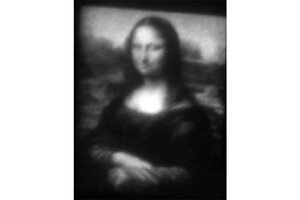'Mini Lisa': Georgia Tech researchers create world's tiniest da Vinci reproduction
Researchers at the Georgia Institute of Technology have created a reproduction of the 'Mona Lisa' that is no wider than a third of the width of a human hair.

Georgia Tech researchers have created the "Mini Lisa" on a substrate surface approximately 30 microns in width. The image demonstrates a technique that could potentially be used to achieve nano-manufacturing of devices because the team was able to vary the surface concentration of molecules on such short length scales.
Courtesy of the Georgia Institute of Technology
Most people who visit the Mona Lisa at the Louvre are surprised at how small it is. Leonardo da Vinci's iconic painting measures just 30 inches by 21 inches.
But even this minuscule masterpiece looks huge next to what researchers at the Georgia Institute of Technology have created. Using a tiny heated probe, a team of scientists have 'painted' a grayscale replica of the Mona Lisa that is more than 25,000 times smaller than the original.
The "Mini Lisa," as it is known, is just 30 millionths of a meter wide. That's roughly 0.001 inches, or one third of the width of a human hair.
According to a study published online by the journal Langmuir, the team created it using a powerful microscope and a process known as ThermoChemical NanoLithography, or TCNL. Using a microscopic cantilever, an anchored beam with a tiny, downward-facing point at one end, a patient Georgia Tech doctoral candidate named Keith Carroll, heated tiny spots on a surface to create a series of chemical reactions to create new molecules: The more heat Mr. Carroll applied, the more molecules he created, making the surface appear lighter.
Each "pixel" was 125 billionths of a meter wide – smaller than the smallest known bacteria – and Carroll and the rest of the research team went pixel-by-pixel to create the reproduction.
Their efforts were more than just an attempt to create a nanoscale artistic movement: “We envision TCNL will be capable of patterning gradients of other physical or chemical properties, such as conductivity of graphene,” said Georgia Tech physics professor Jennifer Curtis, the study's lead author, in a press release. “This technique should enable a wide range of previously inaccessible experiments and applications in fields as diverse as nanoelectronics, optoelectronics and bioengineering.”

